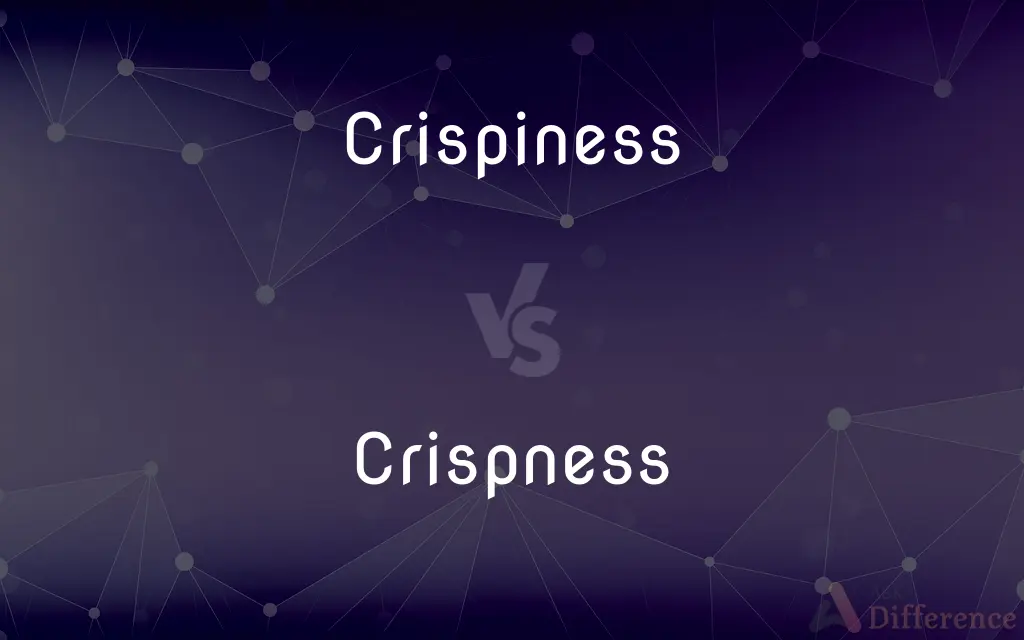Crispiness vs. Crispness — What's the Difference?
By Tayyaba Rehman & Maham Liaqat — Updated on March 18, 2024
Crispiness refers to the texture of food characterized by a satisfying crunch, whereas crispness describes a broader sense of freshness or firmness in various contexts.

Difference Between Crispiness and Crispness
Table of Contents
ADVERTISEMENT
Key Differences
Crispiness is a quality specifically associated with food, indicating a satisfyingly crunchy or brittle texture that is often sought after in fried or baked goods. It's a sensory experience that combines sound, mouthfeel, and taste, making it a critical attribute in culinary terms. Crispness, on the other hand, can apply to a variety of items beyond food, such as the air on a chilly morning or the condition of freshly laundered clothing, denoting freshness, firmness, or a certain bracing quality.
The appreciation of crispiness in food involves auditory and tactile feedback—eating crispy food like chips or fried chicken generates a pleasing crunch that enhances the eating experience. Crispness, while it can describe the texture of food like fresh vegetables, more broadly relates to the overall freshness or invigorating quality of an object or experience.
Crispiness is often achieved through specific cooking methods, such as frying, baking, or roasting, which remove moisture from the food's outer layer, creating a crunchy texture. Crispness, in contrast, might refer to the natural state of an item, like crisp autumn air, or the result of particular care, such as clothes ironed to crisp perfection.
In culinary contexts, achieving the perfect level of crispiness can be a sign of skill, requiring precise timing and temperature control. Conversely, crispness in non-food contexts often denotes a well-maintained or refreshing state, such as crisp sheets or a crisp morning.
While crispiness primarily appeals to the sense of taste and hearing, crispness evokes a broader range of sensory experiences, including touch and smell, indicating the quality of freshness or cleanness in various scenarios.
ADVERTISEMENT
Comparison Chart
Definition
The quality of being satisfyingly crunchy.
The quality of being fresh or firm.
Context
Primarily used to describe food textures.
Used in both food and non-food contexts.
Sensory Experience
Involves sound and mouthfeel.
Involves a broader range of senses.
Achievement
Achieved through cooking methods.
Can be natural or achieved through care.
Examples
Fried chicken, chips.
Fresh vegetables, crisp air.
Compare with Definitions
Crispiness
Dependent on cooking methods to remove moisture.
Achieving the perfect crispiness in cookies requires precise baking.
Crispness
A quality of being firm and fresh.
The crispness of the morning air invigorated the hikers.
Crispiness
A texture of food that breaks easily with a satisfying crunch.
The crispiness of the fried chicken was unparalleled.
Crispness
Often sought in various aspects of life for a sense of renewal.
The crispness of the newly opened book was delightful.
Crispiness
Relates to the outer texture of food.
The crispiness of the crust made the pie exceptionally good.
Crispness
Can describe the texture of non-cooked foods.
The crispness of the apple was a sign of its freshness.
Crispiness
Sought after in various cuisines for sensory experience.
The crispiness of tempura is a testament to the chef's skill.
Crispness
Applies to conditions beyond food, indicating freshness or briskness.
The crispness of the laundered shirt gave a feeling of cleanliness.
Crispiness
Associated with auditory pleasure in eating.
The crispiness of fresh potato chips is part of their appeal.
Crispness
Denotes a refreshing or energizing quality.
The crispness of the garden after rain brought the plants to life.
Crispiness
Crispiness or crispness is one of the most common food texture attributes. Crispiness refers to a hard food that emits a sound upon fracturing.
Crispness
Firm but easily broken or crumbled; brittle
Crisp potato chips.
Crispiness
Firm but easily broken or crumbled; crisp.
Crispness
Pleasingly firm and fresh
Crisp carrot and celery sticks.
Crispiness
Having small curls, waves, or ripples.
Crispness
Bracing; invigorating
Crisp mountain air.
Crispiness
The state of being crispy
Crispness
Lively; sprightly
Music with a crisp rhythm.
Crispiness
Firm but easily broken
Crispness
Conspicuously clean or new
A crisp dollar bill.
Crispness
Marked by clarity, conciseness, and briskness
A crisp reply.
Crispness
Having small curls, waves, or ripples. Used of hair.
Crispness
To make or keep crisp.
Crispness
To become or remain crisp.
Crispness
Something crisp or easily crumbled
The roast was burned to a crisp.
Crispness
A dessert of fruit baked with a sweet crumbly topping
Apple crisp.
Crispness
Chiefly British A potato chip.
Crispness
The state of being crisp.
Crispness
An instance of being crisp.
Crispness
The state or quality of being crisp.
Crispness
A pleasing firmness and freshness;
Crispness of new dollar bills
Crispness of fresh lettuce
Crispness
A style of expression that is direct and to the point;
The crispness of his reply
Crispness
Firm but easily broken
Common Curiosities
Can non-food items be described as crispy?
Typically, "crispy" is reserved for describing food textures, while "crisp" can describe both food and non-food items.
Is crispness always desirable?
Yes, in both food and non-food contexts, crispness is often associated with positive qualities like freshness, cleanliness, and invigoration.
What does crispiness refer to?
Crispiness refers to the crunchy texture of food that makes a satisfying sound when eaten.
What role does moisture play in crispiness and crispness?
In crispiness, removing moisture is key to achieving the texture, whereas crispness in non-food contexts doesn't necessarily relate to moisture levels.
How does crispness differ from crispiness?
Crispness describes a sense of freshness or firmness and is used in a broader range of contexts than the culinary-specific term crispiness.
What methods are used to achieve crispiness in food?
Cooking methods like frying, baking, or roasting that remove moisture to create a crunchy texture.
Is there a cultural preference for crispiness in food?
Many cultures value crispiness in certain foods for its sensory appeal, though the preferred foods and cooking methods can vary.
How does the texture of crispy food enhance the eating experience?
The texture and sound of crispy food enhance the sensory experience, making eating more enjoyable.
Why might someone prefer crisp foods?
People might prefer crisp foods for their satisfying texture and the contrast they provide in a meal.
Can crispness be applied to textiles?
Yes, crispness can describe the fresh, firm quality of textiles, such as ironed clothes.
Can crispness be restored to food that has become soft?
In some cases, reheating or re-crisping methods can restore crispness to foods that have softened.
Can the term crispness apply to weather?
Yes, crispness can describe the fresh, brisk quality of air, particularly in cooler weather conditions.
How do chefs ensure crispiness in their dishes?
Chefs control the cooking time, temperature, and method to ensure the outer layer of the food achieves the desired level of crunch.
What factors can affect the crispness of food and non-food items?
Factors include humidity, temperature, and the method of storage or preparation.
How does crispness contribute to the appeal of fresh produce?
Crispness in fresh produce indicates freshness and quality, appealing to both taste and touch.
Share Your Discovery

Previous Comparison
Oscilloscope vs. Oscillograph
Next Comparison
Unacquainted vs. UnfamiliarAuthor Spotlight
Written by
Tayyaba RehmanTayyaba Rehman is a distinguished writer, currently serving as a primary contributor to askdifference.com. As a researcher in semantics and etymology, Tayyaba's passion for the complexity of languages and their distinctions has found a perfect home on the platform. Tayyaba delves into the intricacies of language, distinguishing between commonly confused words and phrases, thereby providing clarity for readers worldwide.
Co-written by
Maham Liaqat













































